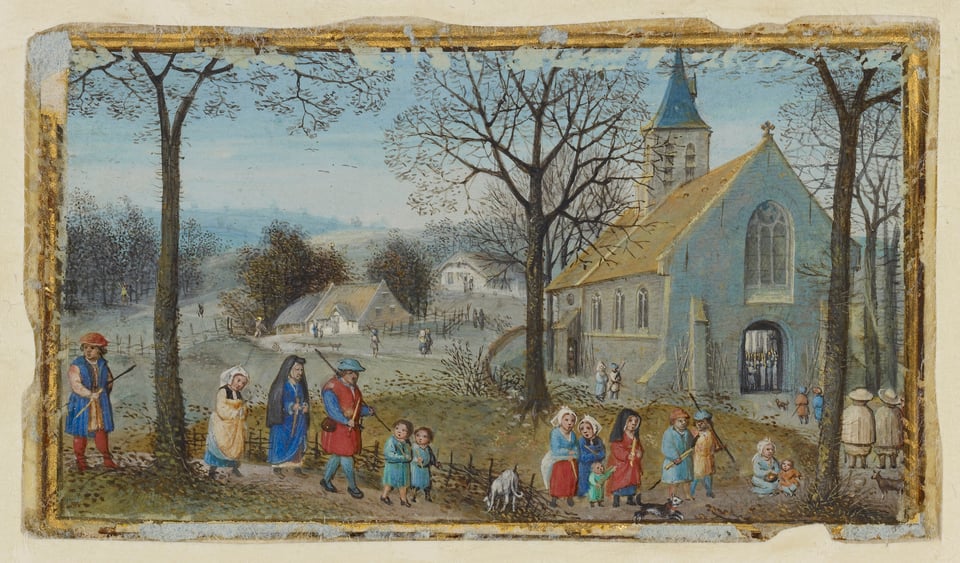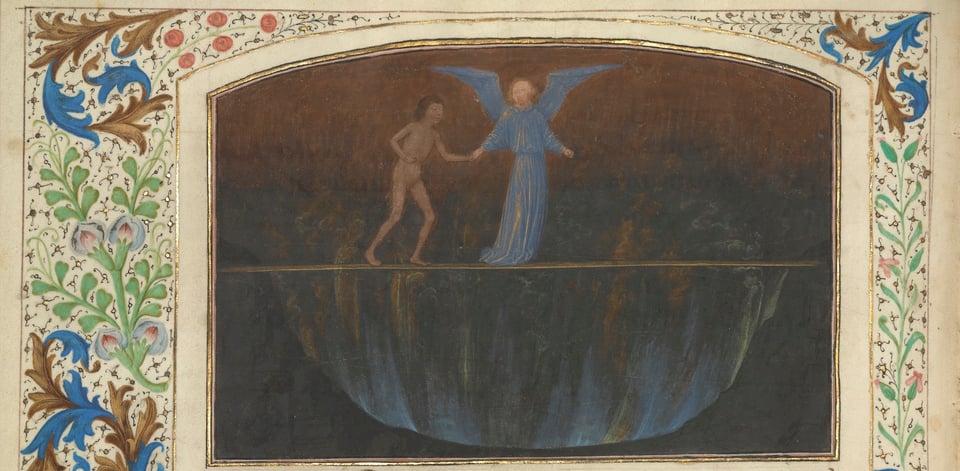Travel in the Middle Ages
A Conversation with Larisa Grollemond about a New Exhibition at the Getty Museum (LA)

Modern Medieval
by David M. Perry and Matthew Gabriele
Today on the newsletter, we’re delighted to be speaking with Larisa Grollemond, an associate curator of manuscripts at the Getty Museum in LA.
Larisa joined the Department of Manuscripts at the Getty Museum in 2016, after earning her PhD in the history of art from the University of Pennsylvania in that same year. Her research areas include late medieval and Renaissance French illuminated manuscripts and paintings, multimedia 15th-century visual culture, early printing, materiality, royal patronage of the arts, and modern medievalisms. Her exhibition projects include Book of Beasts: The Bestiary in the Medieval World (2019), Blurring the Line: Manuscripts in the Age of Print (2019), Transcending Time: The Medieval Book of Hours (2021), The Fantasy of the Middle Ages (2022), Blood: Medieval/Modern (2024), and Rising Signs: The Medieval Science of Astrology (2024). She hosts a short-form video series called Medieval Tymes, available on the Getty’s social media accounts (@gettymuseum on IG), and can be found on Bluesky at @larisag.bsky.social.
The reason we’re speaking with Larisa is that the Getty - with a LONG track-record of really fabulous exhibitions on the Middle Ages, has a new one opening - “Going Places: Travel in the Middle Ages.” We spoke with her over email (responses have been very lightly edited for clarity):

Simon Benig (Flemish, ~1483-1561)
Getty MS 50 (93.MS.19), recto
Modern Medieval: Why "travel?" Many who look at the (European) Middle Ages, think of it as a closed off space in which people were kind of stuck wherever they were - that zombie myth of the "dark ages" still lingers. Does this exhibition confront that (or other pop misconceptions)?
Larisa Grollemond: I try to choose topics for my exhibitions that connect directly to contemporary experience, and things that our visitors will find relatable in some way. The concept of “travel,” seemed really rich to me because it offered an opportunity to take something that’s familiar to the average person today (and especially visitors to the Getty, who are both local and who come from very far away as tourists themselves) and contextualize it in a medieval way to highlight both points of connection and overlap as well as aspects that might be surprising or unexpected.
I worked with our 2024—2025 graduate intern, Ben Allsopp to develop the concept for the exhibition, and he really helped shape the narrative of the show that addresses instances of both relatively common and extraordinary instances of travel. In our early conversations, it became clear that we needed to introduce the medieval idea of what constituted a reason to undertake a journey, the practical ways people moved around (i.e., modes of travel), and also address the ways in which medieval travel was very different from today.
In some ways, the average experience of travel in the European Middle Ages is somewhat predictable for modern audiences: a lot of people did mostly stay where they were and traveled only short distances and overwhelmingly by foot. In other senses, there was perhaps a surprising amount of movement, and often over very long distances, for so many different reasons: religious pilgrimages, relic translations, diplomacy, trade, war, and even forced travel (expulsions, slavery, etc.). The show also deals with the idea of imagined travel — the existence of faraway places and the kinds of potentially strange, even dangerous creatures and people which might call those places home.
The challenge with exhibitions like this is to use our permanent collection to tell as wide a variety of stories as possible to give visitors a broad sense of narrative while still digging down into individual objects and images. One of my constant goals in communicating about the Middle Ages is to try to myth bust some of the stereotypical views of the period perpetuated by pop culture, but I try to also acknowledge the truth that might linger behind those views and work with visitor knowledge to add nuance and detail.
MM: What did you yourself learn in putting this exhibition together?
LG: I always learn so much about what non-specialists/non-medievalists think and believe about the Middle Ages when talking to my museum colleagues about exhibition topics, and the kinds of things to which they think our audiences will respond. For this exhibition, a lot of the questions I got centered on the really practical aspects of travel: what did people bring with them, how long did it take to get to certain places, what was the status of roads and other standardized routes in the Middle Ages, did people travel in groups, were there medieval equivalents of tour guides/guidebooks? The answers to questions like that are often fun to research, and not the sort of thing that’s often in my scholarly purview as an art historian.
These questions in part motivated the creation of “Pilgrimage Road,” a gamified version of the pilgrimage to Santiago de Compostela which will be available for visitors to play in the gallery and will also eventually be available online. I worked with our team in the Interactive Content department, and our Manuscripts department graduate intern this year, Reed O’Mara, to develop an 8-bit style arcade game inspired by early versions of Oregon Trail (dysentery anyone?), but which engages some of these practical aspects of medieval travel in a fun (and hopefully also educational) way. In making their way through the game, players learn about the basics of the pilgrimage to Santiago, how social class influenced travel options, practical aspects of time and distance, supplies and anecdotes from locals drawn from medieval sources, and of course the potential perils of the journey along the way.
MM: What do you wish you could've included in the exhibit but couldn't?
LG: Most of the smaller exhibitions in the manuscripts gallery at the Getty are drawn from the permanent collection, so of the 22 objects in the show, 21 are Getty manuscripts (plus one printed book on loan from the Getty Research Institute, a frequent partner of ours). The collection is exceptionally rich and there was plenty to choose from for this show, but I always wish that I could have even more on display. A larger iteration of this exhibition would also ideally include non-European books that would illustrate a more global experience of travel from different geographical perspectives, as well as artifacts including pilgrim badges that would expand visitor understanding of the material culture created by and in support of medieval travel.
MM: What's it like doing public-facing work in a museum? The Getty has had a number of just really phenomenal medieval-themed exhibitions recently, so how have the public reacted? Any favorite audience anecdotes from such exhibitions?
LG: Public-facing museum work is always equal parts invigorating and humbling. It’s really a privilege to be able to share all the things I love about the Middle Ages with curious audiences, but I’m also being constantly reminded that my exhibitions and museum visitation in general (as well as engagement with museum content online and on social media) are one of a million things competing for people’s attention.
It seems to me more important than ever to present history in an interesting way that illuminates the richness of human experience in all dimensions, but it must be accessible. Curators have to write not just for our non-specialists, but also people who aren’t quite sure when the Middle Ages was, as well as people who’ve never visited a museum before.
I never expect for visitors to be experts, nor do I expect them even to read all the text in the gallery, but I think if a single object, image, or an idea presented in the exhibition gets people thinking in a different way, then I’ve done my job. Museums can be spaces that facilitate a lot of different kinds of learning. If that is historical learning, great, but I think the best kinds of public-facing work are really about now, and I always hope to create something about the Middle Ages that prompts audiences to reconsider their own world and place within it in some small way.
The public really does react strongly when exhibitions engage a topic with which they’re familiar in some way. When exhibitions address issues that still feel quite relevant today (politics, physical aspects of the body, issues of faith, social and cultural identities, prejudice, and discrimination), audiences are really quick to make the connections between the medieval/historical and today, often in pretty sophisticated (if sometimes unexpected) ways.

Simon Marmion (Flemish, active 1450 – 1489)
Getty MS 30 (87.MN.141), fol. 15v
One of my recent exhibitions about medieval astrology really illustrated this for me—I knew the topic would resonate in the gallery (the show was inspired by a series of IG videos on different signs I had already been working on), but visitors really brought a lot of preexisting knowledge (and some assumptions) that was in some cases deepened by the exhibition, but for others their knowledge was contextualized in a different way, the historical information offered a different way of seeing and understanding a really familiar topic. I myself am not a big believer in astrology, but it prompted some soul-searching among some visitors on public tours I gave, since there are lots of points of commonality between medieval and contemporary understandings of the zodiac, but the ruling planets for some of the signs are different now than they were in medieval science, and that had some of the more astrologically-minded folks really off-balance. And the linkage between medieval astrological knowledge and medicine in particular had people asking me if bloodletting during certain astrological seasons was really that beneficial.
“Going Places: Travel in the Middle Ages” runs September 2 - November 30 and entry is free, though there is a fee for parking.
-
Don't leave us hanging! How did LG answer that last question!?
Add a comment: